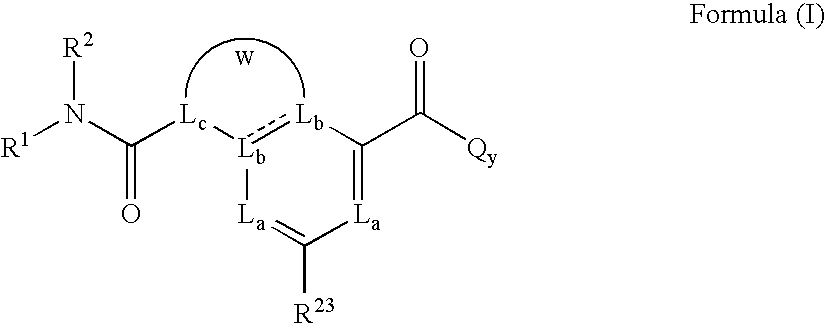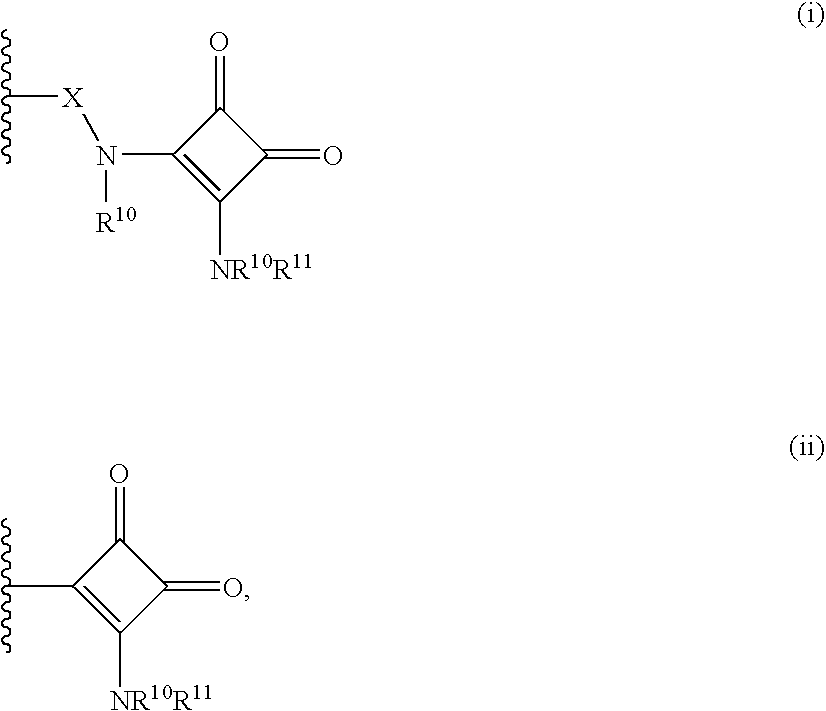Heterobicyclic metalloprotease inhibitors
a metalloprotease inhibitor and heterobicyclic technology, applied in the direction of biocide, drug composition, cardiovascular disorder, etc., can solve the problem of developing effective mmp inhibitors
- Summary
- Abstract
- Description
- Claims
- Application Information
AI Technical Summary
Problems solved by technology
Method used
Image
Examples
example 5
PREPARATIVE EXAMPLE 5
[0296]
Step A
[0297]Commercially available 5-Bromo-3H-benzooxazol-2-one (1 g) was dissolved in DMF (15 ml) and Zn(CN)2 (1.09 g) added. The mixture was 25 sonicated for 5 Min while a stream of nitrogen was bubbled through the solution. After the addition of Pd[P(Ph)3]4 (0.54 g), the mixture was heated at 100° C. oil bath temperature for 18 h. The solvents were evaporated and the residue purified by chromatography on silica using EtOAc / cyclohexane (20:80->50:50) to afford the title compound as white solid (674 mg; 91%; MH+=161).
Step B
[0298]The title compound from Step A above (300 mg) was dissolved in MeOH (40 ml) and NiCl2×6H2O (44.4 mg) and Boc2O (816 mg) added. The mixture was cooled to 0° C. and NaBH4 (495 mg) was added in portions. After the addition was completed, the mixture was stirred overnight and allowed to reach room temperature. The solvents were evaporated and the residue dissolved in EtOAc. The organic phase was washed with sat. NaHCO3, dried over MgS...
example 6
PREPARATIVE EXAMPLE 6
[0300]
Step A
[0301]The title compound from Preparative Example 5 Step A (374 mg) was dissolved in DMF (30 ml) and NaH (112 mg) added. The mixture was stirred at room temperature for 2 h, CH3I (358 μl) added and stirring at room temperature was continued overnight. The solvents were evaporated and the residue dissolved in EtOAc. The organic phase was washed with H2O, dried over MgSO4, filtered and the solvents evaporated to afford the title compound as pale yellow solid (398 mg; 99%; MH+=175).
Step B
[0302]The title compound from Step A above (398 mg) was treated with NiCl2 x 6H2O (52 mg) and NaBH4 (582 mg) in the presence of Boc2O (960 mg) as described in Preparative Example 7 Step B to afford the title compound (546 mg; 89%; MH+=279).
Step C
[0303]The title compound from Step B above (546 mg) was treated with 4 M HCl / dioxane (10 ml) as described in Preparative Example 7 Step C to afford the title compound as yellow solid (420 mg; quant.; MH+=179).
example 7
PREPARATIVE EXAMPLE 7
[0304]
Step A
[0305]To a solution of commercial available ethyl 2-cyano-3-ethoxyacrylate (8.46 g) in abs. ethanol (35 ml) was added commercial available diethyl amino malonate hydrochloride (10.58 g). The resulting mixture was stirred at room temperature for 10 min. Then a solution of sodium ethanolate in ethanol (40.53 ml, 2.7 M) was added. The mixture was heated to reflux for 16 h. After cooling to room temperature formamidine acetate (10.51 g) was added. To the vigorously stirred mixture acetic acid (3.46 ml) was added and the mixture was heated to reflux for 68 h. The mixture was cooled to room temperature and filtered. The resulting solid was suspended in ethanol (300 ml). After filtration the obtained solid was dried to afford the crude title compound as grey solid, which was used without further purification. (8.6 g: 83%; MH+=208).
Step B
[0306]To a heated solution of POBr3 (100 g) the title compound from Step A above (14.5 g), was added. The suspension was h...
PUM
| Property | Measurement | Unit |
|---|---|---|
| temperature | aaaaa | aaaaa |
| temperatures | aaaaa | aaaaa |
| temperature | aaaaa | aaaaa |
Abstract
Description
Claims
Application Information
 Login to View More
Login to View More - R&D
- Intellectual Property
- Life Sciences
- Materials
- Tech Scout
- Unparalleled Data Quality
- Higher Quality Content
- 60% Fewer Hallucinations
Browse by: Latest US Patents, China's latest patents, Technical Efficacy Thesaurus, Application Domain, Technology Topic, Popular Technical Reports.
© 2025 PatSnap. All rights reserved.Legal|Privacy policy|Modern Slavery Act Transparency Statement|Sitemap|About US| Contact US: help@patsnap.com



